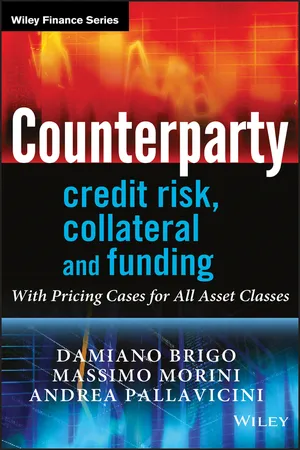![]()
Part I
COUNTERPARTY CREDIT RISK, COLLATERAL AND FUNDING
![]()
1
Introduction
This chapter is based on the summary given in Brigo (2011b) [34].
In this introductory chapter we present a dialogue that clarifies the main issues dealt with in the book. This chapter is also a stand-alone informal guide to problems in counterparty risk valuation and measurement, with references for readers who may wish to pursue further the different aspects of this type of credit risk. Later chapters in the book will provide in-depth studies of all aspects of counterparty risk.
1.1 A DIALOGUE ON CVA
Although research on counterparty risk pricing started way back in the nineties, with us joining the effort back in 2002, the different aspects of counterparty credit risk exploded after the start of the global financial crisis in 2007. In less than four years we have seen the emergence of a number of features that the market operators are struggling to account for with consistency. Further, the several possible definitions and methodologies for counterparty risk may create confusion. This dialogue is meant to provide an informal guide to the different aspects of counterparty risk. It is in the form of questions and answers between a CVA expert and a newly hired colleague, and provides detailed references for investigating the different areas sketched here in more detail.
1.2 RISK MEASUREMENT: CREDIT VaR
Q: [Junior colleague, he is looking a little worried] I am new in this area of counterparty risk, and I am struggling to understand the different measures and metrics. Could you start by explaining generally what counterparty risk is?
A: [Senior colleague, she is looking at the junior colleague reassuringly.] The risk taken on by an entity entering an Over-The-Counter (OTC) contract with one (or more) counterparty having a relevant default probability. As such, the counterparty might not respect its payment obligations.
Q: What kind of counterparty risk practices are present in the market?
A: Several, but most can be divided into two broad areas. Counterparty risk measurement for capital requirements, following Basel II, or counterparty risk from a pricing point of view, when updating the price of instruments to account for possible default of the counterparty. However, the distinction is now fading with the advent of Basel III.
Q: [Shifts nervously] Let us disentangle this a little, I am getting confused.
A: Fine. Where do we start from?
Q: Let us start from Counterparty Risk Measurement for Capital Requirements. What is that?
A: It is a risk that one bank faces in order to be able to lend money or invest towards a counterparty with relevant default risk. The bank needs to cover for that risk by setting capital aside, and this can be done after the risk has been measured.
Q: You are saying that we aim at measuring that risk?
A: Indeed, and this measurement will help the bank decide how much capital the bank should set aside (capital requirement) in order to be able to face losses coming from possible defaults of counterparties the bank is dealing with.
Q: Could you make an example of such a measure?
A: A popular measure is Value at Risk (VaR). It is basically a percentile on the loss distribution associated with the position held by the bank, over a given time horizon. More precisely, it is a percentile (say the 99.9th percentile) of the initial value of the position minus the final value at the risk horizon, across scenarios.
Q: Which horizon is usually taken?
A: When applied to default risk the horizon is usually one year and this is called “Credit VaR (CrVaR)”. If this is taken at the 99.9-th percentile, then you have a loss that is exceeded only in 1 case out of 1,000. The Credit VaR is either the difference of the percentile from the mean, or the percentile itself. There is more than one possible definition.
Q: Is this a good definition of credit risk?
A: [Frowning] Well what does “good” really mean? It is not a universally good measure. It has often been criticized, especially in the context of pure market risk without default, for lack of sub-additivity. In other terms, it does not always acknowledge the benefits of diversification, in that in some paradoxical situations the risk of a total portfolio can be larger than the sum of the risks in a single position. A better measure from that point of view would be expected shortfall, known also as tail VaR, conditional VaR, etc.
Q: And what is that?
A: This is loosely defined as the expected value of the losses beyond the VaR point. But this need not concern us too much at present.
Q: Fine. How is Credit VaR typically calculated?
A: Credit VaR is calculated through a simulation of the basic financial variables underlying the portfolio under the historical probability measure, commonly referred to as P, up to the risk horizon. The simulation also includes the default of the counterparties. At the risk horizon, the portfolio is priced in every simulated scenario of the basic financial variables, in...
